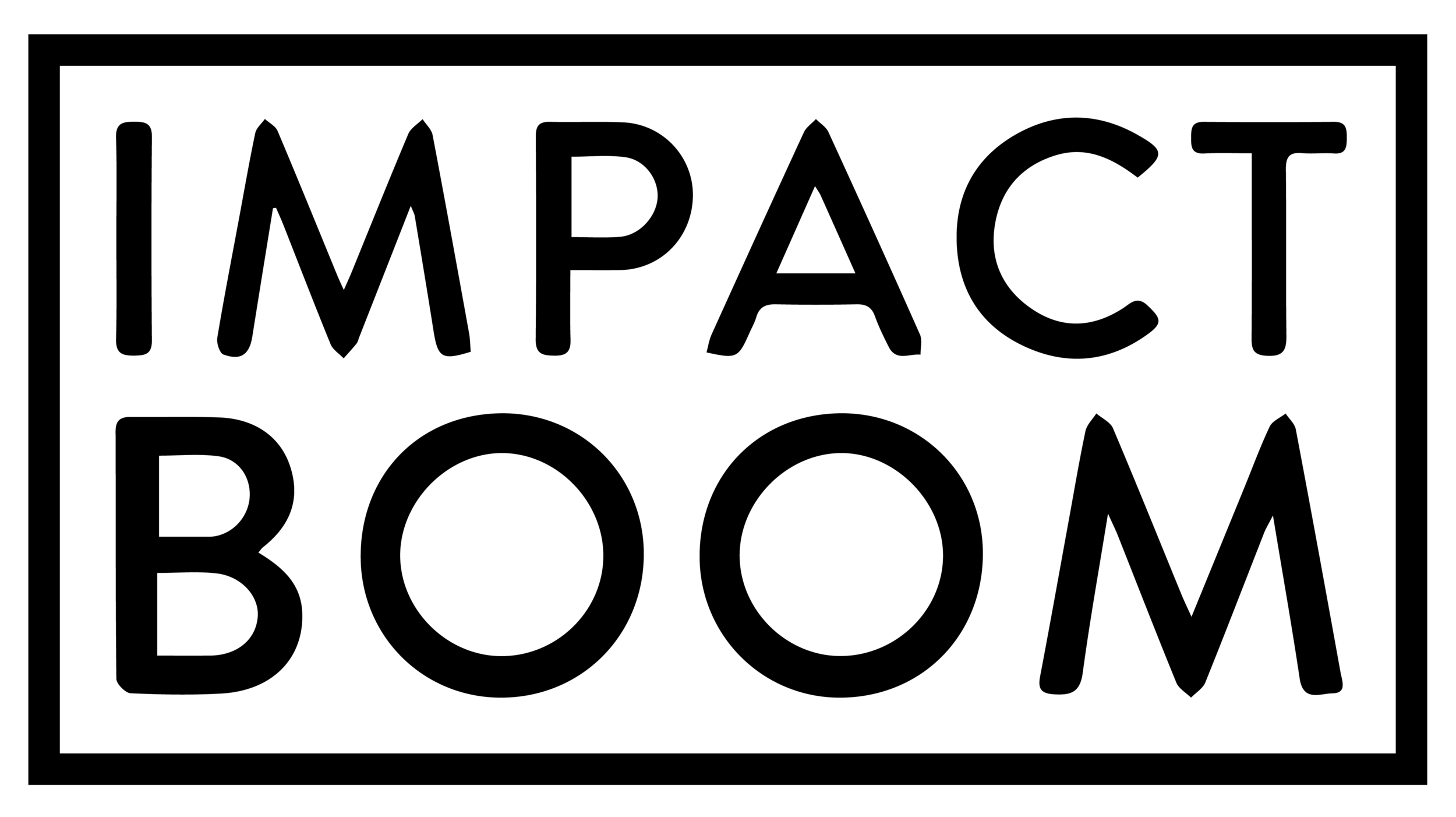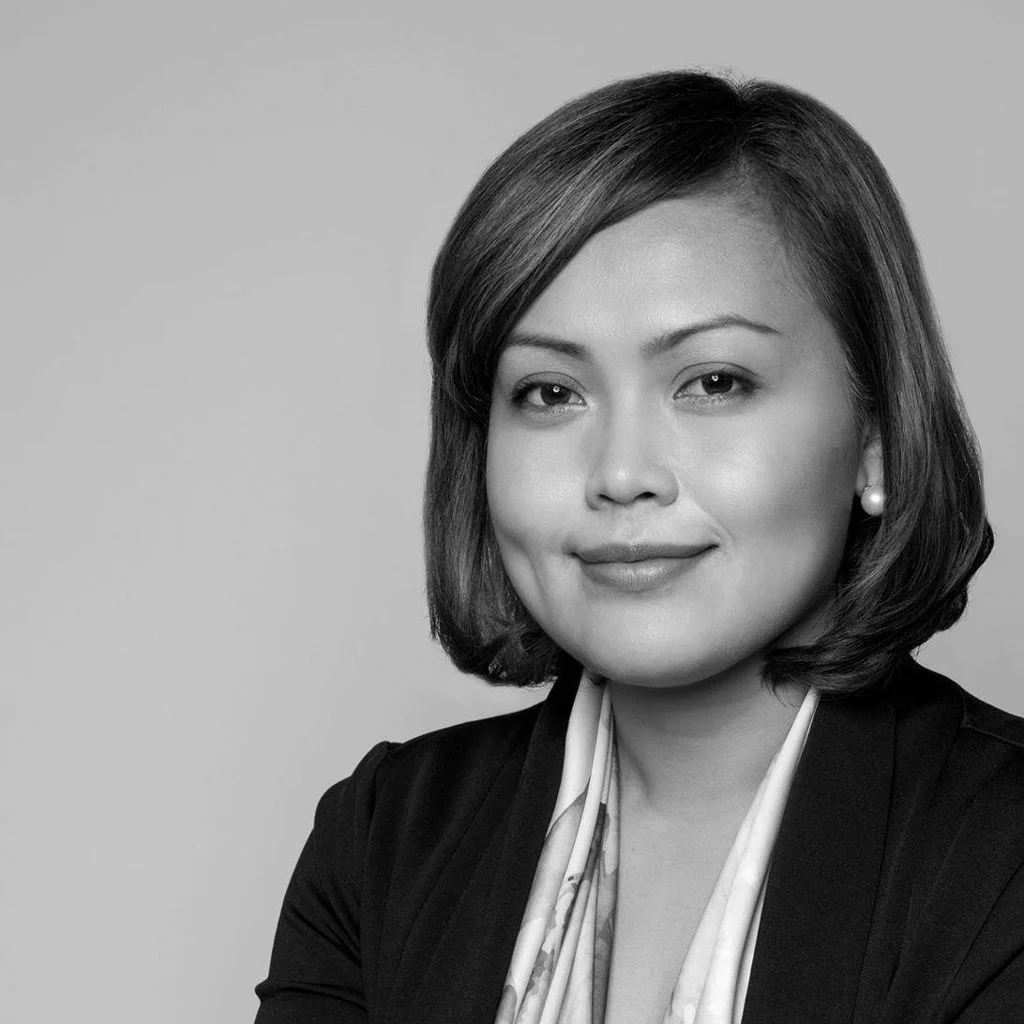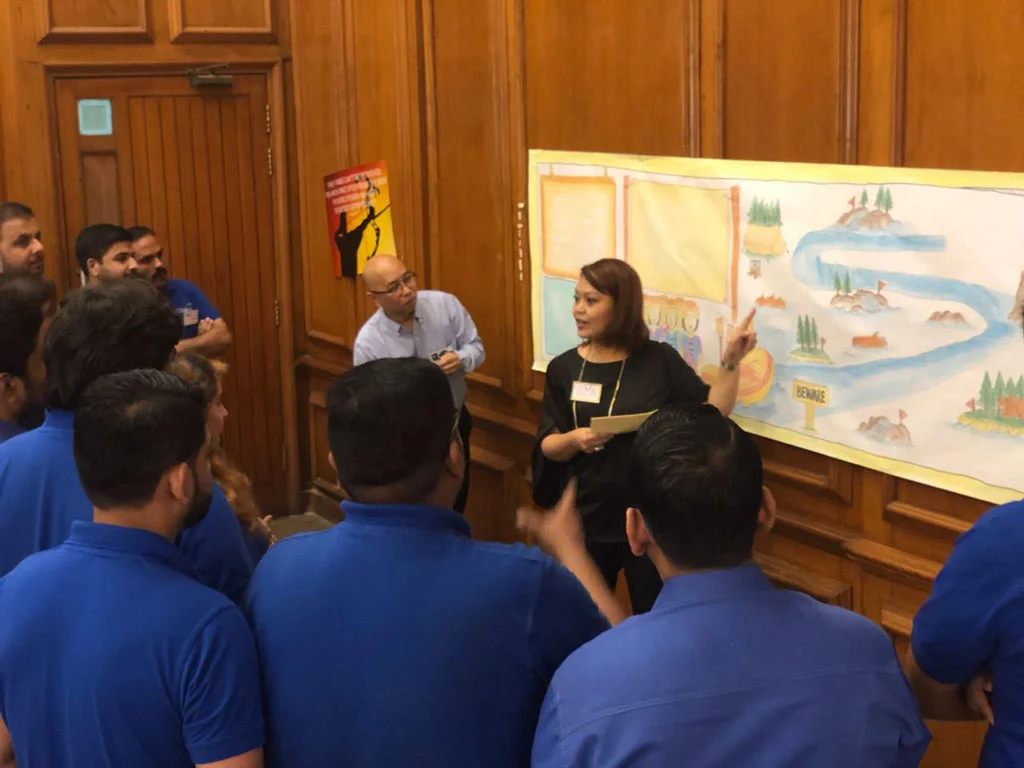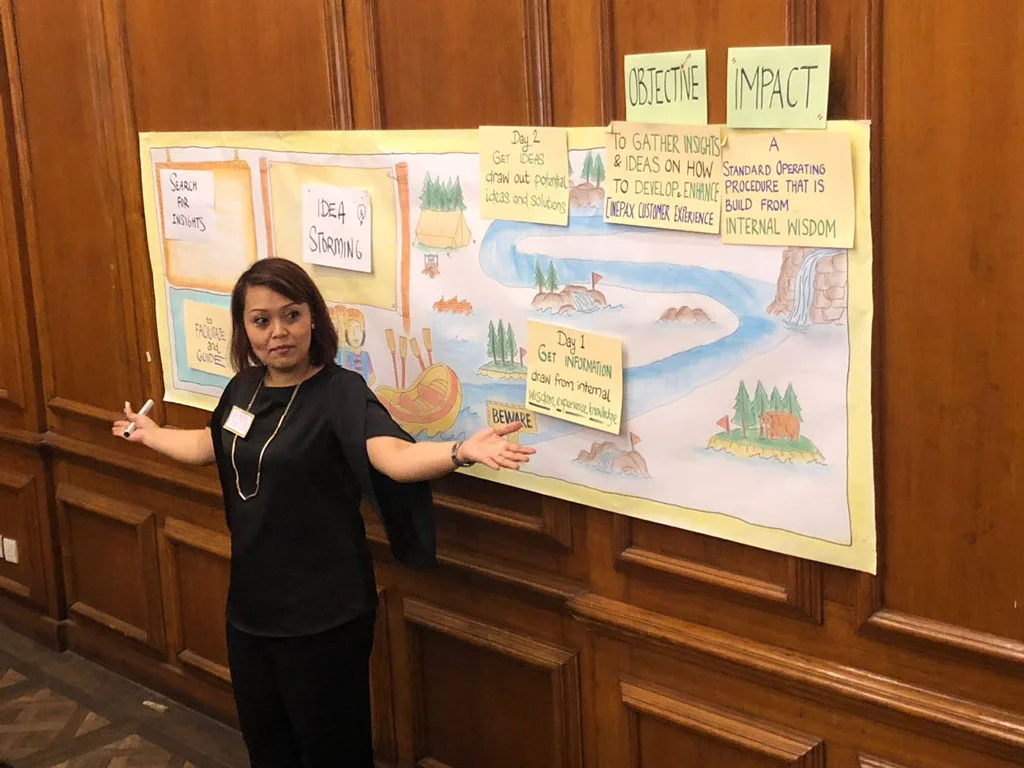Yasmin Ahmad Mazlani On Designing Holistically To Create Positive Social Impact
TZE YASMIN is currently the managing director of NEOONE Associates Sdn Bhd; a boutique human potential consulting firm based in Kuala Lumpur. The firm specialises in using Ontology, Design Thinking, Graphic Facilitation, Story Practice and Accelerated Learning as their design and learning methodology. She is one of the company’s lead facilitator, coach and learning strategist.
Tze Yasmin is a speaker at the Social Enterprise World Forum.
She is a great visualiser and high calibre in mapping learning processes. She is well known in Malaysia for championing Accelerated Learning, Graphic Facilitation and Story Practice. Yasmin is Manager of the Social Enterprise Academy, Malaysia.
Tze Yasmin graduated from NTU Singapore with a Masters in Technopreneurship and Innovation. She is an accomplished Accelerated Learning Master Practitioner from the International Association of Accelerated Learning Practitioners ( IAALP) in the US.
She lives and play with her 4 children in Kuala Lumpur.
Yasmin discusses human centred design, story practice and accelerated learning in Asia, sharing insights into the local movement and opportunities for the region.
Highlights from the interview (listen to the podcast for full details)
[Tom Allen] - Could you please share a bit about your background and what led you to a career specialising in ontology, human centred design and story practice?
[Yasmin Ahmad Mazlani] - NeOOne started in 2010, and it was founded by myself and my co-founder, Rosihan Juara. What we believe is that in any learning and development, there's a need to embed personal growth or transformational work, not just purely skills and knowledge alone. Because, what we notice is that, a lot of skills and knowledge are not lasting, because the missing piece is the motivation and the core essence of being, of that person. As such, they will not appreciate any skills and knowledge transferred much because they don't really know who they are and how they should show up in this world.
I would like to respond to your question, with regards to NeOOne using ontology, human centred design, or, what is known as design thinking and story practice in our work. It all started when I was exposed to the personal growth training based on Werner Erhard’s work, which is mainly on critical thinking, transformational models and application, integrity, performance, leadership, and/or individual and organisation transformation.
So, ontology; a lot of people mistake it with oncology, which has nothing to do with ontology. Ontology is strictly about how we are being in life and how we show up in life. It's about conservation, practice in awareness, observing our own being in relation to others and the world. Ontology, based on what we practice in NeOOne, whenever we design our program, we look at the three domains: which is the body, the emotional, and the language. We see these three aspects as territory of learning. It is how we encompass these three things; how we live it in our life so that we can lead to deeper capacity to live in life.
So, this is a part in anything that we do. This is the core before we look at the skills and knowledge. What we have done, is we applied the ontology approach seamlessly in our soft skills training. More often than not, our practice firm doesn't know that we are embedding the approach in the design because it's very gentle and very subtle. Because, if I were to embed or to use this ontology in the design, they would be like, "What is that all about?" So, we don't tell them what ontology is about; we just mention that we're focusing on working on their body, emotion, and language whenever we run our workshop. That is called the ontology core. With regards to human centred design, it was a very interesting journey for us, as we didn't realise that we apply that framework, because it's very intuitive for us.
In any of our work, our first approach before we design a program for our clients, is to engage the client in deeper conversation to really understand what's their issues and challenges, before we come up with a solution.
I feel that the last three years, we were introduced to human centred design and me and my partner say, "Hey, we have been doing this for many years." It's just for me, right now, human centred design is the framework that we use to coming up with solutions for our client.
So in our consulting work, especially in Learning and development, it is always given that when we engage the clients, we not just engage the clients, we also engage the stakeholders to understand their needs, so that we design something that is of impact, not design something by chance; so that the solution will be a holistic and systemic.
Last but not least, I want to talk about story practice. Story practice is basically a transformative tool as it is about application of the story. A lot of people are used to storytelling, but story practice moves beyond storytelling and focuses on the connection with the theme and the metaphors contained within the story. It facilitates the movement between the imaginary and the real world; what's happening in their life currently. This is to assist clients to find new solutions or strategies and expand their understanding when they look at the situation that they have. Basically, story practice is relatively, very new. I just found this two years ago, and I applied it, and I realised that it adds a lot of new perspective in that dimension to the solution that we propose to our clients. In Malaysia, we are basically known as an organisation that uses story practice very extensively, human centred design, and, of course, the other method is accelerated learning.
It sounds like some really interesting work, Yasmin. So, as Managing Director, of NeOOne, how are you applying these different processes and methodologies that you're talking about into specific projects? What sort of projects are you involved in, and what outcomes do they really seek to achieve within the communities or organisations that they're working with?
Just now I mentioned accelerated learning; most of the work that we do is very much personalised for the client's specific needs. When I say personalised, it's not the same as customised. Customised is, for example, you go to a shop, you buy a shirt, and then you realise that the line of the shirt doesn't suits your hands. So, you go to the tailor, get it trimmed, and make it shorter. But the shirt is already hanging on the rack. That is customise; you take it, and you just trim it. But, with personalise, it means you need to build from scratch, meaning there's no solution or there's no framework. You need to invent the framework that does that.
So, this is where accelerated learning is widely used in how we design our program because we are required to engage the stakeholders and understand the whole situation. That also includes interviewing the people in the organisation, immersing ourself in the day to day operations, and conducting surveys and focus groups. That is the pre-work that we do, which is, in Accelerated Learning what we call learner preparation. There is five phases to learner preparation: the connection phase, where we connect the activity to relate the big "why" they need to learn certain thing, or they need to adapt to certain solution. And, then, we get them to discover the concept and, then, get them to play with it, and then move to the activation phase. The activation phase is basically when the participant has already discovered what they have learned. This is the phase where they apply what they have learned. And, then, the last phase is integration. How would I use this thing that I learned and apply it in my organisation, so that I can perform better, or I can make the process better?
The solutions are very much personalised, and, sometimes, the solutions/projects that we get are not limited to only training or workshops, but sometimes, involve process improvement. For example, enhancing the existing SOP, or known as Standard Operation Procedure, and, also, sometimes looking at policies and suggesting what would be a policy that the organisation could consider to enhance the performance. Sometimes, they look into the technology, maybe certain pivots need to be given about the processes to make sure everything moves smoothly. So, the outcome, as you mentioned, just now, has always been about getting individuals in the organisation, and the organisation itself, to unleash their potential. For example, we had a client in Pakistan. It's a cinema chain. They are in the process of expansion. So, they want to have another 10 more cinemas all over Pakistan. They already have their SOP, but what they realise is that their SOP can be better because of a few things. There are a lot of new hires which are young adults that have no working experience, so the SOP that they have now is very much, I would say, boring not exciting. So, we call into what else they can do to make sure that the SOP is very interesting, meaningful and practical, so that everyone, when they look at their SOP, they get excited about using it. So, we did that work with this cinema chain in Pakistan. And, this is the part where it's not enough that we designed the SOP; we need to train the people to adapt to the new change that is happening in the organisation. So we designed a leadership development program for the managers.
Another example that we are currently designing, is on developing transfer of technology for a social innovation camp based in Sri Lanka for the UNDP. What they are looking at, is they want to run their own social innovation camp, but they don't know how to go about it. So, we were approached to come up with the design of the social innovation camp and design of facilitators toolkit to enable the locals to train the innovation camp in the future. So, it's a whole series of engagement with the local facilitators and training, and also coaching that is highly personalised to fit with Sri Lanka's audience.
The last one that I thought would be interesting for me to share is, we were tasked to design impact driven enterprise accreditation accelerator. I know it's a long word, but, in short, it's called IDEA Accelerator. It is an Accelerator program for a government agency. So, basically, we train people who have ideas for social innovation or social enterprise, and they want to learn how to make the ideas very detailed and, also, able to be sustained. It is a six week intensive program, and we have completed this project last month. We used all the methodologies that I have mentioned to you just now: human centred design, story practice and accelerated learning.
It sounds like some fascinating projects, particularly the accelerator program. So, what advice would you give to the budding social entrepreneurs listening who are keen to start a purpose driven enterprise?
For me, before you start anything, the most important thing is about grounding self. What I mean by grounding self, is that you have this clarity on the outcome that the entrepreneur wants to see happen.
So, if I were to do this, what do I want to see in terms of impact, and why is it important to the community to be able to achieve this? Second, is the importance of who they need to be to make things happen. How do they need to show up, as such, so that we can get things done? They can involve the committee. And also, last but not least, once they are clear about what outcome they want to see happen, they are clear about who they need to be to get things done. Third is to identify their current gap within their own enterprise, within the community, and the ecosystem of the committee before any new intervention, or any new solution, or any learning and development design to be infused in their organisation, or the community.
So, working from Kuala Lumpur, how have you seen the design innovation social enterprise sectors transform and change over the last five years, and where do you see it heading now?
Based on my observations, I will share mostly what I see in Malaysia, and also other Social Enterprises that I encounter.
What I realise is that there is a lot of social innovation work under the radar, but they are doing great work. It's just that they are not known and making it visible.
For example, in Malaysia, I came across a few that are based on creativity and culture, but only one or two. But, when I go to impact driven networking, I get to know more, which I have never heard of. And, they are doing great work, that is, for Malaysia. When I say that, I'm just focusing on the creative and cultural social innovation, not in general.
In general, there are many services but not so much product innovation. If I were to relate to the social innovation sector in different countries that I came across, for example, Pakistan, Sri Lanka, Bangladesh, where the social issues are more challenging, I would say social innovation has a lot of potential because you can't rely on government to solve all the problems, all the social issues that you have in a country. Personally, I anticipate a bright future with regards to creative and cultural based social innovation. I believe if we have more incubators that are friendly to creative and cultural based social innovation it would spark more opportunities and possibilities. The other thing that I like is, anything to do with creativity; you can't go wrong with that.
It sounds like you've worked in a diverse range of countries in the area. So what countries do you believe are really leading the charge when it comes to social innovation, and what are they doing that you think other countries can adopt?
I think Indonesia, Philippines, Thailand, Sri Lanka, Pakistan and India are leading the change as the social innovators, as they are very diverse in terms of their social issues, and they are very organic. Some of them don't have proper learning and development but they do it anyway.
That's why I thought, "Wow, without having that proper learning and development, they are creating a lot of remarkable outcomes." So, my question would be: 'What if they were provided with an extensive learning and development program, so that they can make even more impact, more sustainably?' So, what I hope is that the thing that these countries do, based on my engagement and heavy conversation with them, is that more and more civil society based organisations, or NGOs, shifting gears to social enterprise to make sure that they are able to sustain their mission through enterprise. [There are] more and more requests on how to do this. 'I have a fantastic mission that I'm championing, but the funds and funding are getting scarce.' So, this is what I know is the emerging needs of learning and development in social enterprise education.
Are there any particular inspiring projects or initiatives that you've come across recently, which you believe are creating some really positive social change?
I came across an interesting one based in Pakistan. They are an NGO. The beneficiaries are families of missing people. They say that in Pakistan, through war, there are hundreds of thousands of families where the brothers or the fathers were taken away, and left behind were the women and the kids. And, they don't have income to sustain the families, so there are a hundred thousand of them. So, what this NGO does, is that they identify these families and are looking at what other things they can do. They realised that these people come from across Pakistan from different tribes, and different tribes have different kinds of crafts that are very unique to people out of Pakistan. So, what they want to do, now, is to have a social enterprise that they will be able to market these crafts to the world. They are working on business model and how to get initial seed funding to work on this. That is one that I came across. I thought that was very unique.
The other one is called "Bring Me Home" and is based in Sri Lanka, led by a transgender person. What happened is that a lot of transgender people are faced with sexual abuse and a lot of social issues because they were rejected by their families. So, this person set up a home where he provides a place for transgender people to come and empower them with skills, so that they have something that they can do and to pursue their dream. One of the success stories that he has, was a transgender person who turned out to be a successful runway model in New York. So, when I looked at the stories it was amazing. This is just one example, of course. He has a few more that he wants to share, but this one is the most outstanding one.
A couple of really interesting projects there. So to finish off then, what books would you recommend to our listeners?
I have three books that is very dear to me: The first one is Language and the Pursuit of Happiness by Chalmers Brothers. This is related to the ontological work. How you can use body, emotion, and language to transform your life and perform.
The second book is Conscious Business by Fred Kofman. So, I thought anyone, regardless of whether they are in social enterprise or not, or social innovation or not, you must read this book. It's a fantastic book that will transform the way how you see business.
Last, but not least, is Start With Why by Simon Sinek.
Fantastic. Yasmin, you've shared some really interesting insights today, and we're certainly looking forward to seeing you at the Social Enterprise World Forum in Edinburgh in September, where you're a speaker.
Recommended books
Language and The Pursuit of Happiness by Chalmers Brothers.
Conscious Business by Fred Kofman.
Start With Why by Simon Sinek.










